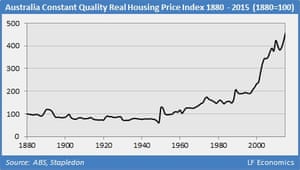Extract from The Guardian
The rapid rise of capital city house prices in the
past two years has propelled Australia past Denmark with a ratio of
123.08% debt to GDP, analysis shows
House prices have risen 141% in Australia since
1996.
Photograph: David Gray/REUTERS
Photograph: David Gray/REUTERS
Contact author
Friday 15 January 2016 12.41 AEDT
The results are in: Australian households have
more debt compared to the size of the country’s economy than any
other in the world.
Research by the Federal Reserve has shown the
consolidated household debt to GDP ratio increased the most for
Australia between 1960 and 2010 out of a select group of OECD
nations. Australia’s household sector has accumulated massive
unconsolidated debt compared with other countries. As of the third
quarter of 2015, it now has the world’s most indebted household
sector relative to GDP, according to LF
Economics’ analysis of national statistics.
Denmark long held this unholy accomplishment, but
has been slowly deleveraging over the last several years as its
housing bubble peaked and burst during the GFC. The latest
debt-financed boom in Sydney and Melbourne has resulted in
Australia now overtaking Denmark, a comparison of official figures
from Australia and Denmark has shown.

Photograph: LF Economics
Australia has around $2 trillion in unconsolidated
household debt relative to $1.6 trillion in GDP. Australia’s ratio
is 123.08%, while Denmark’s fell slightly to 122.99% in the third
quarter of 2015, a marginal difference of 9 basis points. Although
Denmark holds the record in terms of peak debt of 140.14% in the last
quarter of 2009, as Australia continues to leverage and Denmark
deleverages the current gap between the two will widen. Apart from
Switzerland (which alongside Denmark
has a negative interest rate), no other country is close in terms of
having such extreme household sector debts. The UK ratio is 85.9%
while in the US it is 79.1%.
Due to Switzerland’s opaque financial accounts,
it is impossible to calculate a figure for this quarter. Its ratio
for the second quarter of 2015 is 121.3%, and household debt is
rising very slowly, so it would take an extraordinary increase over
the quarter to potentially beat Australia.
The final confirmation of the trend is expected
when the Bank of International Settlements publishes its analysis of
private credit statistics from the third quarter.
Australian property investors and homeowners are
burdened with massive mortgages, especially new and marginal
entrants. Unlike winning a gold medal at the Olympics, having the
world’s most indebted household sector is not an achievement the
nation should be proud of. This is where Australia’s real debt and
deficit problem lies, not
in the public sector.
Over the last two decades, Australia has been
beset by rampant housing price inflation.
Since 1996, prices have outpaced fundamentals such
as inflation, incomes, construction costs, rents and GDP, making it
difficult for potential first home buyers to enter the market while
lower income households and marginal groups struggle to afford decent
shelter.
Between 1996 and 2015, housing prices (adjusted
for inflation and quality) have boomed by 141%, without a large and
obvious downturn. This surge has led to a heated debate over whether
this constitutes an asset bubble. Unfortunately, the Australian
housing market shares similarities with countries afflicted by such
bubbles: the United States, Spain, Denmark, the Netherlands and
Ireland.
Government, the FIRE sector (finance, insurance
and real estate) and the mainstream economics profession deny the
existence of a real estate bubble, but Australia’s economic history
demonstrates they occur repeatedly, with all signs pointing to one
today.
Contrary to the analyses of the vested interests,
the data clearly establishes Australia is in the midst of the largest
housing bubble on record.

Photograph: LF Economics
Government is caught between a rock and a hard
place, as implementing needed reforms will likely burst the bubble,
causing severe financial and economic problems as residential land
prices decline. The FIRE sector, including the public caught in the
fallout, will surely blame government for the bust and deflect
attention away from the gargantuan amount of debt pumped out by
lenders.
One of the faults of real estate analysis is the
failure to distinctly define an asset bubble, so debate on the matter
is kept necessarily vague. Only a couple of housing market metrics is
needed to identify a bubble, and are now considered commonplace:
nominal price to inflation, price to income and price to rent. On all
three, Australia is both historically and internationally at or near
the top.
Since the advent of the GFC, it has become
commonly accepted that the global real estate booms originated from
rapidly expanding bank credit or private mortgage debt. It is not
merely the growth of mortgage debt (the first derivative) but the
acceleration (the second derivative), also known as the change in the
rate of growth. Nevertheless, the simple growth of mortgage debt
provides a strong indicator for housing price growth.
The future for investors and new homeowners is not
good. Subdued capital price growth in the secondary capital cities,
rental price growth at record lows, significant dwelling construction
and a falling population growth rate leading to further oversupply
all spell danger. The problems are compounded by the Reserve bank
having little room for interest rate cuts, by weak macroprudential
controls, minimal savings, low household income growth and anaemic
GDP growth.
Captured by neoliberal ideology and the FIRE
sector, government has no interest in stopping this immensely
profitable yet dangerous gravy train, having enriched the already
wealthy beyond avarice through privatisation of unearned economic
rents rather than productive activity.
Philip Soos is the co-author of Bubble
Economics: Australian Land Speculation 1830-2013 and co-founder of LF
Economics. @PhilipSoos


No comments:
Post a Comment